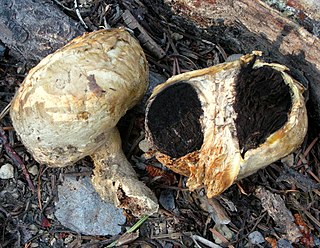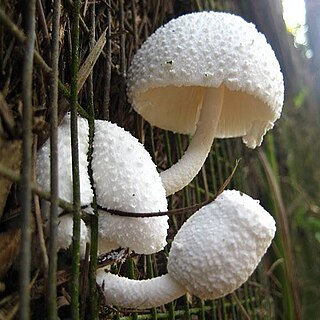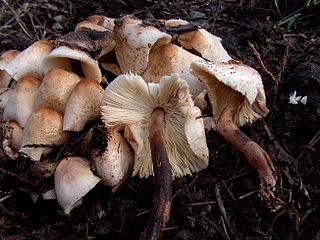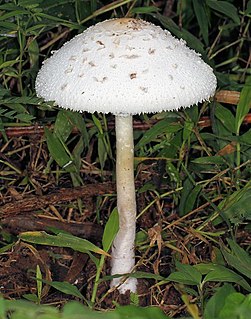
Macrolepiota procera, the parasol mushroom, is a basidiomycete fungus with a large, prominent fruiting body resembling a parasol. It is a fairly common species on well-drained soils. It is found solitary or in groups and fairy rings in pastures and occasionally in woodland. Globally, it is widespread in temperate regions.

Macrolepiota is a genus of white spored, gilled mushrooms of the family Agaricaceae. The best-known member is the parasol mushroom (M. procera). The widespread genus contains about 40 species.

Macrolepiota clelandii, commonly known as the slender parasol or graceful parasol, is a species of mushroom-forming fungus in the family Agaricaceae. The species is found in Australia and New Zealand, where it fruits singly or in small groups on the ground in eucalypt woodlands, parks, and roadsides. It is a tall mushroom up to roughly 20 cm (8 in), with a broad cap covered with distinctive rings of dark brown scales. The whitish gills on the cap underside are closely spaced and free from attachment to the slender stipe, which has a loose ring on its upper half, and a bulbous base. The edibility of the mushroom is not known with certainty, but closely related parasol mushrooms are edible and some are very sought after.

Agaricus inapertus is a species of secotioid fungus in the genus Agaricus. It was first described by American mycologists Rolf Singer and Alexander H. Smith in 1958 as Endoptychum depressum. Molecular analysis later proved it to be aligned with Agaricus, and it was formally transferred in a 2003 publication.

Leucocoprinus cretaceus is a species of mushroom producing fungus in the family Agaricaceae. It is likely tropical in origin although it was first documented in Europe where it was often found growing in greenhouses and bark beds. However many early observations conflate this species with Leucocoprinus birnbaumii or Leucocoprinus cepistipes despite sharing only some superficial similarities. This fungus is quite versatile even for a saprotroph and is often found growing in clusters on woodchips, sawdust and compost heaps as well as directly from the ground or on trees. It may also appear in plant pots and greenhouses in colder countries in which it is not well equipped to survive outside.

Leucoagaricus badhamii is a species of fungus in the family Agaricaceae. The flesh of this mushroom turns blood red when cut or bruised, hence its common name of blushing dapperling. These damaged areas may eventually turn brown or black and likewise the mushroom may discolour brown or black with age. All parts of the flesh display red staining aiding in identification.
Leucocoprinus straminellus is a species of mushroom producing fungus in the family Agaricaceae. Like other Leucocoprinus species it may have originated in a tropical climate but now finds a home in plant pots, greenhouses and compost piles in many countries. Leucocoprinus straminellus is described as being similar to the more commonly known Leucocoprinus birnbaumii but it is smaller and a lighter shade of yellow with smaller spores that lack a germ pore. It is also described as being superficially similar to Leucocoprinus fragilissimus but slightly more robust with flesh that is less translucent.

Leucoagaricus meleagris is a species of fungus in the family Agaricaceae.

Leucoagaricus nympharum is a species of fungus in the family Agaricaceae.

Coprinopsis nivea is a species of mushroom producing fungus in the family Psathyrellaceae. It is commonly known as the snowy inkcap.
Leucocoprinus biornatus is a species of mushroom producing fungus in the family Agaricaceae.
Leucocoprinus holospilotus is a species of mushroom producing fungus in the family Agaricaceae.
Leucocoprinus discoideus is a species of mushroom producing fungus in the family Agaricaceae. In the local language when the mushroom cap is open it is known as batakania or bepokua pembe when it is immature with a closed cap. However 'bepokua' may also be used to refer to other similar looking mushroom species such as Micropsalliota bambusicola.
Leucocoprinus citrinellus is a species of mushroom producing fungus in the family Agaricaceae.
Leucocoprinus tropicus is a species of mushroom producing fungus in the family Agaricaceae.
Leucocoprinus zeylanicus is a species of mushroom producing fungus in the family Agaricaceae.

Macrolepiota zeyheri is a species of mushroom producing fungus in the family Agaricaceae. In the Kilendu dialect it is known as djilo and in the Kilur dialect it is called n'volo mighom.
Leucocoprinus martinicensis is a species of mushroom producing fungus in the family Agaricaceae.
Leucocoprinus magnusianus is a species of mushroom producing fungus in the family Agaricaceae.
Leucoagaricus lacrymans is a species of mushroom producing fungus in the family Agaricaceae.










